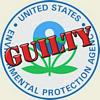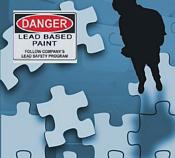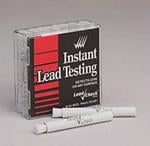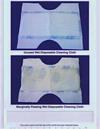 Painting and Coatings Terms and Definitions:
Painting and Coatings Terms and Definitions:
The following is a list of general terms and definitions related to painting and paints. This information is not specific to lead based paint or RRP work, but is listed here as a resource.
Terms and Definitions:
Acrylic: A synthetic polymer used in high-performance latex or water-based paints. As the paint's binder, acrylic resins enable the coating to last longer and retain its color.
Acrylic Latex Paint:Water-thinned paint which employs acrylic resin as the majority of the binder. Other binders which may be added to reduce cost or add specific properties include styrene, epoxy, and poly-vinyl acetate.
100% Acrylic Latex Paint:Water-thinned paint in which only acrylic resin is used as the binder medium. Typically the highest quality latex paints used for a wide variety of architectural coatings, 100% Acrylic Latexes have superior adhesion, long-term flexibility, breathability, alkali resistance, toughness, and color and sheen retention.
Acrylic Resin:Resins which have established a pre-eminent position among coating formulators, having shown superiority in such respects as color and gloss retention, alkali and oxidation (chalk) resistance, hardness, adhesive and cohesive strength, and overall film durability. Generically, resins resulting from the polymerization of derivatives of acrylic acids, including esters of acrylic acid, methacrylic acid, acrylonitrile, and their copolymers. Also known as acrylate resins.
Adhesion:The ability of dry paint to remain on the surface without blistering, flaking or cracking. Adhesion is probably the single most important property of paint. Wet adhesion, the ability of dry paint to adhere to the surface in spite of wet conditions, is particularly important for exterior house paints.
Airless Spraying: Process of atomization of paint by forcing it through an orifice at high pressure. The effect is often aided by the vaporization of the solvents, especially if the paint has been previously heated.
Alkyds:Resins used mostly in trim paints, inside and out, although some medium duty equipment and marine enamels employ these resins as binders. Most often alkyd resins are found in vehicles employing aliphatic hydrocarbons (mineral spirits or other refined petroleum distillate) as thinner. Alkyds offer good leveling properties and cure to a relatively durable film, but tend to yellow interior and embrittle with age. Color and gloss exterior is only fair, and alkyds are highly prone to failure exterior on surfaces containing even moderate levels of moisture. Chemically, alkyds are synthetic resins formed by the condensation of polyhydric alcohols with polybasic acids. They may be regarded as complex esters. The most common polyhydric alcohol used is glycerol, and the most common polybasic acid is phthalic anhydride. Modified alkyds are those in which the polybasic acid is substituted in part by a monobasic acid, of which the vegetable oil fatty acids are typical.
Binder:The binder cements the pigment particles into a uniform paint film and also makes the paint adhere to the surface. The nature and amount of binder determine most of the paint's performance properties -- washability, toughness, adhesion, and color retention. Acrylic polymers are the binder of choice in producing quality high-performance latex paints.
Bleaching: Loss of color, usually caused by exposure to sunlight.
Blistering: The formulation of dome-shaped, hollow projections on paint, often caused by heat or moisture. Can also be caused by solvent entrapment in a paint film which has surface dried before the solvent has completely escaped.
Chalking: Formation of a friable powder on the surface of a paint film caused by the disintegration of the binding medium due to disruptive factors during weathering. The chalking of a paint film can be considerably affected by the choice and concentration of the pigment. It can also be affected by the choice of the binding medium.
Color Retention: The ability of paint to keep its original color and resist fading.
Consistency: The resistance of a paint to flow. A paint with high consistency flows slowly; a paint with low consistency flows readily.
Cracking: Breaks or splits in the paint's surface.
Durability: The degree to which paint withstands the destructive effects of the environment to which it is exposed, especially harsh weather conditions. Durability has two aspects. Its protective properties safeguard the substrate from degradation. Its decorative properties allow the paint to retain its attractive appearance.
Efflorescence: An encrustation of soluble salts, commonly white, deposited on the surface of coatings, stone, brick, plaster, or mortar; usually caused by salts or free alkalies leached from mortar or adjacent concrete as moisture moves through it.
Elasticity: The ability of paint to expand and contract with the substrate without suffering damage or changes in its appearance. Expansion and contraction are usually caused by temperature fluctuations. Some substrates such as yellow pine expand at different rates depending on the type of their grain. Elasticity is a key to durability. Acrylic binders are noted for their elasticity.
Enamel: (1) Topcoat which is characterized by its ability to form a smooth surface; originally associated with a high gloss, but may also include lower degrees of gloss, i.e., flat enamels. (2) A class of substance having similar composition to glass with the addition of stannic oxide, SnO2, or other infusible substances to render the enamel opaque.
Extender: A less-expensive ingredient than titanium dioxide that fills out and extends the pigment's capabilities. Extender cannot be used without pigment. Some common extenders are clays, calcium carbonate, and silica.
Fading: Lightening of the paint's color, usually caused by exposure to light or heat.
Film Formation: The paint's ability to form a continuous dry film. This process is the result of the water or solvents evaporating and the coming together of the binder particles. A continuous dry film repels water.
Flaking: The detachment of pieces of paint from the substrate, caused by a loss of adhesion and elasticity. Also known as scaling.
Glycol:A co-solvent, combined with water in aqueous (latex) systems to form the total thinner. Various glycols perform various functions, however, they are generally valuable as brushing agents and for temperature stability (ethylene glycol is the chief ingredient in anti-freeze). Generically, CH2OHCH2OH. General term for dihydric alcohols; ethylene glycol is the most simple of the glycols.
Grain raising:Swelling and standing up of the wood grain caused by absorbed water or solvents.
Hiding Power: The ability of paint to hide or obscure a surface, color or stain over which it has been uniformly applied. Hiding power is provided by the paint's pigment.
Holidays: Application defect whereby small areas are left uncoated. Syn: Misses, Skips, Voids, Discontinuities, Vacations.
Industrial paint: Paint that would normally be used to paint industrial items such as structural steel, chemical plants, and pulp and paper mills. It usually has greater chemical resistance and a faster drying time than regular house paint.
Intumescent Coatings:Fire retardant coating which, when heated becomes plastic and produces nonflammable gasses, such as carbon dioxide and ammonia. The gasses are trapped by the film, converting it to a foam about fifty times as thick as the original paint film. At this stage, the film solidifies, resulting in a thick, highly insulating layer of carbon, which effectively protects the substrate from fire.
Joint cement: Cement used in dry wall construction as a bedding compound for joint tape and as a filler for nail holes.
Joint tape:Special paper tape or paper-faced cotton tape used over joints between panels of wallboard to conceal the joint and provide a smooth surface for painting.
Latex: (1) Stable dispersion of a polymeric substance in an essentially aqueous medium. (2) Fine dispersion of rubber or resin, natural or synthetic, in water; the synthetic is made by emulsion polymerization. (Strictly speaking, after polymerization a latex is a solid dispersed in water, and therefore is not an emulsion. Latex and emulsion are often used synonymously in the paint industry.)
Latex Paint: Water-thinned paint made with synthetic binders such as polyvinyl acetate or acrylic resins. In contrast to oil-based paint, latex paint dries fast, flows smoothly, and cleans up easily with water. High-performance latex paints contain 100% acrylic resins.
Leveling: The ability of a coating to form a smooth film without brush marks appearing. Higher quality latex paint has superior leveling ability.
Linseed oil: A drying oil used in paint, varnish and lacquer.
Mildewcide: Chemical agent in quality paint that retards mildew, a common problem in humid climates.
Peeling: The detachment of paint from the surface in ribbons or sheets. Like flaking, the result of loss of adhesion.
Pigment: Finely ground, natural or synthetic, inorganic or organic, insoluble dispersed particles (powder) which, when dispersed in a liquid vehicle to make paint, may provide, in addition to color, many of the essential properties of the paint: opacity, hardness, durability, and corrosion resistance. The term is used to include extenders, as well as white or color pigments. The distinction between powders which are pigments and those which are dyes is generally considered to be on the basis of solubility. Pigments being insoluble and dispersed in the material, dyes being soluble or in solution when used.
Polymer:This binder is produced from petrochemical feedstocks. The binder's polymer particles are small in size and carried in water. The binder polymers and water mix is known as emulsion.
Primer: The base coat, or first complete coat, of a paint system that is applied to an uncoated surface. Primer can be latex or alkyd paint.
PVA (Polyvinyl Acetate): A colorless, thermoplastic, water soluble, resinous high polymer derived from the polymerization of vinyl acetate with a catalyst; used as a latex binder in certain, generally lower quality water-base coatings.
PVC (Pigment Volume Concentration): The ratio of the volume of pigment to the volume of total nonvolatile material (i.e., pigment and binder) present in a coating. The figure is usually expressed as a percentage.
Resin:(1) General term applied to a wide variety of more or less transparent and fusible products, which may be natural or synthetic. They may vary widely in color. Higher molecular weight synthetic resins are generally referred to as polymers. (2) A solid, semi-solid, or pseudo-solid organic material that has an indefinite and often high molecular weight, exhibits a tendency to flow when subjected to stress, usually has a softening or melting range, and usually fractures conchoidally. (3) In a broader sense, the term is used to designate any polymer that is a basic material for coatings and plastics.
Sandpaper: A sheet of abrasive-coated paper that is used for smoothing rough surfaces.
Satin finish: Semi-gloss finish.
Silicate:Any one of a large family of substances chiefly used with titanium dioxide, the primary pigment, as an extender pigment. When used in moderation, these silicates (magnesium silicate, aluminum silicate, etc.) are valuable in helping control gloss, aid brushability, and increase hold-out properties and overall exterior durability.
Solids: The solids content of a paint that is left over after the solvent evaporates. Same as nonvolatile.
Spattering: Droplets of paint that spin or mist off the roller as paint is being applied.
Surfactants:Contracted from surface-active agents, these are additives which reduce surface tension and thereby improve wetting (wetting agents), help disperse pigments, inhibit foam, or emulsify. Conventionally, they are classified as to their charge: anionic (negative); cationic (positive); nonionic (no charge); or amphoteric (both positive and negative).
Thinner:The thinner and binder together form the paint's vehicle. Water, the thinner used in latex paints, evaporates as the paint dries, allowing a smooth paint application. Turpentine or spirits are the thinners in oil-based paints.
Thixotropic: Adjective which describes full-bodied material which undergoes a reduction in viscosity when shaken, stirred, or otherwise mechanically disturbed and which readily recovers the full-bodied condition on standing.
Tinting: The final adjusting of a color of paint to the exact shade required.
Titanium Dioxide, Anatase (TiO2):A high opacity, bright white pigment of the chalking type, used as a prime pigment in paints, rubber, plastics. Prepared from the mineral ilmenite, or rutile ore.
Titanium Dioxide, Rutile (TiO2):A high opacity, bright white pigment of the non-chalking type, used as a prime pigment in paints, rubber, plastics. Prepared from the mineral ilmenite, or rutile ore.
Topcoat: A coat designed to provide a finish capable of providing protection and color.
Undercoat: For unpainted surfaces, the coat between the primer and the topcoat. For previously coated surfaces, the undercoat is applied directly to the old paint.
Vehicle: The liquid portion of the paint, in which the pigment is dispersed; it is composed of a binder and a thinner.
Vinyl: (1) The unsaturated, univalent radical CH2: CH -- derived from ethylene. (2) Any of the various compounds containing this group, typically highly reactive, easily polymerized and used as a basic material for coatings and plastics. (3) Any of the various plastics, typically tough and flexible.
VOC (Volatile Organic Content):Any carbon compound that evaporates under standard test conditions. Essentially, all paint solvents except water are VOCs. Federal and state governments are beginning to limit the amount of volatile organics found in paint because of concerns about possible environmental and health effects.
Volume Solids: The volume of pigment plus binder divided by the total volume, expressed as a percent. High volume solids mean a thicker dry film, improved hiding, and high durability.
Washability: Ease with which washing will remove dirt from the paint's surface without causing damage.
Weathering: Paint film deterioration as a result of exposure to the weather.
Wet Edge: Edge of a wet painted area which remains workable. When painting large surfaces, it is generally necessary to join up to the edge of a paint film which has been left for an appreciable time; when this can be done by blending this edge with free working paint without any lap showing, the film is said to present a wet edge.
Zinc Chromate: Bright yellow pigment which chemically is substantially zinc chromate, although its precise composition is rather complex. Its chief use is in anti-corrosive paints and primers for steel.
Zinc Oxide: A fine particle, white pigment used in rubber, paint, and plastic industries for mildew resistance and film reinforcing properties.
Zinc Rich Primer: Anti-corrosive primer for iron and steel incorporating zinc dust in a concentration sufficient to give electrical conductivity in the dried film, thus enabling the zinc metal to corrode preferentially to the substrate, i.e., to give cathodic protection.
SOURCES:
PAINT/COATINGS DICTIONARY, © 1978 by Federation of Societies for Coatings Technology.
PAINT QUALITY INSTITUTE
 Variances in the rule requirements, from the EPA RRP rule and also from state to state, will make it difficult for renovators to understand the differences and keep up with amendments made by each entity. Renovators working in more than one state many have to become certified firms in each state they operate in and or also with the EPA. Are renovators better off if their states write a better thought out rule? Would renovators be better served if there was just one well written rule for everyone to follow? I predict that confusion may likely contribute to violations and fines for these renovators.
Variances in the rule requirements, from the EPA RRP rule and also from state to state, will make it difficult for renovators to understand the differences and keep up with amendments made by each entity. Renovators working in more than one state many have to become certified firms in each state they operate in and or also with the EPA. Are renovators better off if their states write a better thought out rule? Would renovators be better served if there was just one well written rule for everyone to follow? I predict that confusion may likely contribute to violations and fines for these renovators.  In July of this year Massachusetts took over administration and enforcement of the RRP rule. The Massachusetts Regulations, written by the Massachusetts Department of Occupational Safety (DOS), include many of the OSHA related considerations left out of the EPA RRP rule and the EPA required certified renovator training. As a result, Massachusetts contractors are quickly becoming aware of the already existing OSHA considerations related to working with lead. For example, the Massachusetts firm licensing application includes a requirement that a written respiratory protection and worker health and safety program evidencing compliance with the Massachusetts RRP rule and OSHA medical monitoring requirements be submitted with the application. This will force businesses to have such a program in place before they can be licensed to do RRP work. The requirement will also serve to dictate what the business must have in place should they be inspected by either the DOS or OSHA. I predict the need for OSHA related training will increase dramatically as contractors become aware of violations and fines levied against their peers.
In July of this year Massachusetts took over administration and enforcement of the RRP rule. The Massachusetts Regulations, written by the Massachusetts Department of Occupational Safety (DOS), include many of the OSHA related considerations left out of the EPA RRP rule and the EPA required certified renovator training. As a result, Massachusetts contractors are quickly becoming aware of the already existing OSHA considerations related to working with lead. For example, the Massachusetts firm licensing application includes a requirement that a written respiratory protection and worker health and safety program evidencing compliance with the Massachusetts RRP rule and OSHA medical monitoring requirements be submitted with the application. This will force businesses to have such a program in place before they can be licensed to do RRP work. The requirement will also serve to dictate what the business must have in place should they be inspected by either the DOS or OSHA. I predict the need for OSHA related training will increase dramatically as contractors become aware of violations and fines levied against their peers. The MA DOS has also started conducting on-site inspections. Though most inspections are triggered by citizens reporting suspected violations, the DOS is also out in the field and is stopping by renovation projects as they come across them. In one of his recent blogs, RRP certification training provider and business coach, Mark Paskell of The Contractor Coaching Partnership, shares a real life story of a painter who was visited by DOS after a neighbor next door to one of his projects called the DOS with concerns about soil contamination. The contractor was in compliance and made out fine, but the DOS left him with a message and asked that he would share it with others. "Tell every contractor you know we're out there enforcing. Tell your friends, your neighbors, other contractors you know, suppliers and trades. We are here and we will enforce the new law"
The MA DOS has also started conducting on-site inspections. Though most inspections are triggered by citizens reporting suspected violations, the DOS is also out in the field and is stopping by renovation projects as they come across them. In one of his recent blogs, RRP certification training provider and business coach, Mark Paskell of The Contractor Coaching Partnership, shares a real life story of a painter who was visited by DOS after a neighbor next door to one of his projects called the DOS with concerns about soil contamination. The contractor was in compliance and made out fine, but the DOS left him with a message and asked that he would share it with others. "Tell every contractor you know we're out there enforcing. Tell your friends, your neighbors, other contractors you know, suppliers and trades. We are here and we will enforce the new law"
 Looking for accurate information about the EPA RRP rule?
Looking for accurate information about the EPA RRP rule?  The Lead and Environmental Hazard Association (LEHA)
The Lead and Environmental Hazard Association (LEHA)


 If an EPA enforcement employee and and OSHA Field inspector show up at one of your jobsites, at the same time, there is no way you will be able to satisfy both. I suggest this is another example of shortsighted leadership within both organizations. It also points out the lack of knowledge and awareness our political leaders in Congress have as it relates to understanding the construction industry and overseeing the creation of regulations that affect businesses of all sizes.
If an EPA enforcement employee and and OSHA Field inspector show up at one of your jobsites, at the same time, there is no way you will be able to satisfy both. I suggest this is another example of shortsighted leadership within both organizations. It also points out the lack of knowledge and awareness our political leaders in Congress have as it relates to understanding the construction industry and overseeing the creation of regulations that affect businesses of all sizes.

 personal desire and mission Marcia Stone has to help protect the health and well being of families and especially children. According to Marcia; “Our goal for 20 years has been to dramatically reduce lead-poisoning, especially in children where the effects are most severe and permanent. Our continued recognition as the only test kit in the EPA RRP program has given us greater reach to accomplish our goal, and we’re excited to be able to provide contractors with a low cost, easy to use, and accurate test kit to help with compliance to this rule. We are also excited about our position to help the states that are administering their own lead program, including our home state of Massachusetts.”
personal desire and mission Marcia Stone has to help protect the health and well being of families and especially children. According to Marcia; “Our goal for 20 years has been to dramatically reduce lead-poisoning, especially in children where the effects are most severe and permanent. Our continued recognition as the only test kit in the EPA RRP program has given us greater reach to accomplish our goal, and we’re excited to be able to provide contractors with a low cost, easy to use, and accurate test kit to help with compliance to this rule. We are also excited about our position to help the states that are administering their own lead program, including our home state of Massachusetts.” Painting and Coatings Terms and Definitions:
Painting and Coatings Terms and Definitions:
 EPA Communication to EPA Region Headquarters:
EPA Communication to EPA Region Headquarters:



 The U.S. Environmental Protection Agency recently filed a complaint and proposed a $784,380 penalty against Hanson’s Window and Construction Inc. of Madison Heights, Mich., for violations of the 1998 federal rule for failure to warn residents of potential lead-based paint exposures.
The U.S. Environmental Protection Agency recently filed a complaint and proposed a $784,380 penalty against Hanson’s Window and Construction Inc. of Madison Heights, Mich., for violations of the 1998 federal rule for failure to warn residents of potential lead-based paint exposures.
 Lead-based paint dust created during renovations is the most common source of lead exposure to children in the United States. About 75 percent of the nation’s housing built before 1978 contains lead-based paint. When properly managed, lead-based paint poses little risk. If paint is not maintained, however, even low levels of lead exposure can threaten occupants’ health, especially children and pregnant women
Lead-based paint dust created during renovations is the most common source of lead exposure to children in the United States. About 75 percent of the nation’s housing built before 1978 contains lead-based paint. When properly managed, lead-based paint poses little risk. If paint is not maintained, however, even low levels of lead exposure can threaten occupants’ health, especially children and pregnant women
 d. As an extra level of protection for you, your business, your employees, your customer and/or the occupants of the space you are renovating; if you plan to use the strategy suggested in item "1b" above, I suggest you still do the post renovation cleaning and cleaning verification procedure as required under the RRP Rule before restarting work again on July 6th.
d. As an extra level of protection for you, your business, your employees, your customer and/or the occupants of the space you are renovating; if you plan to use the strategy suggested in item "1b" above, I suggest you still do the post renovation cleaning and cleaning verification procedure as required under the RRP Rule before restarting work again on July 6th.



